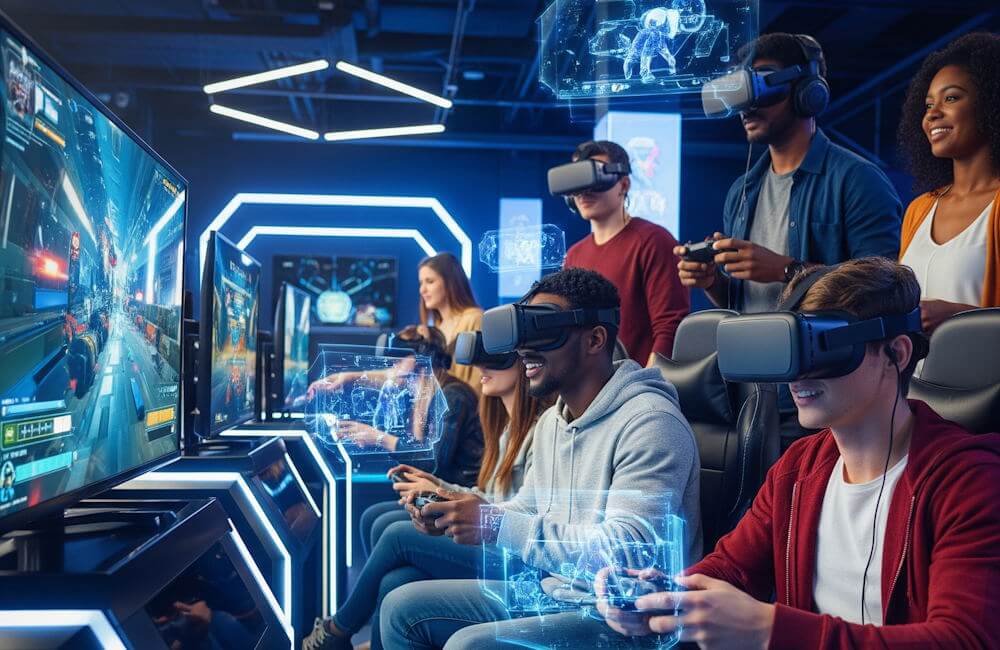Gaming fandoms are vibrant communities formed around shared interests in video games, embracing various forms of engagement that extend beyond mere gameplay. These fandoms consist of enthusiastic individuals who connect through their love for particular games, genres, or franchises. As gaming grew from a niche hobby to a mainstream cultural phenomenon, so too did the rise of these dedicated communities. Social interactions within gaming fandoms often traverse platforms, including online forums, social media channels, and streaming services, facilitating a rich exchange of ideas, strategies, and experiences.
The characteristics that define gaming fandoms are as diverse as the games themselves. Members of these communities often exhibit passionate commitment, where they contribute to discussions, create fan art, and engage in multiplayer gaming sessions. This level of involvement can sometimes blur the lines between casual players and committed fans. Additionally, gaming fandoms often have their own unique vernacular and social norms. These elements help foster a sense of belonging and collective identity among members, elevating their engagement to a more meaningful level.
The evolution of gaming fandoms has been closely tied to technological advancements. From the early days of arcades and home consoles to the rise of the internet and social media, the methods through which fans engage with their favorite games has transformed dramatically. The inclusion of digital communication tools and streaming platforms has enabled fans to share gameplay experiences and foster interactivity in unprecedented ways. Consequently, these technological shifts have enriched the gaming culture, allowing for a more dynamic interaction between players and developers. Moreover, the ability to stream, share content, and engage in real-time discussions has reshaped gaming fandoms, making them increasingly inclusive and expansive.
The Rise of Online Communities
The advent of the internet has fundamentally transformed the landscape of gaming fandoms, facilitating the development of vibrant online communities. These communities have become a critical aspect of modern fandom experiences, enabling fans to connect with one another in unprecedented ways. Platforms such as forums, Discord servers, and social media groups serve as the primary venues for fans to gather, exchange ideas, and collaborate on various gaming-related endeavors.
Forums have long been a staple in the online gaming community, offering dedicated spaces for discussions on game mechanics, lore, and strategies. Websites like Reddit host specific subreddits geared towards particular games, allowing players to share experiences, theories, and creations. This creates an environment where fans can benefit from the knowledge of others, thereby enhancing their gaming experience.
In recent years, Discord has emerged as a popular platform for gamers seeking real-time communication and collaboration. This application not only offers voice and text chat functionality but also enables fans to organize events, share gameplay, and even stream content live. The diverse servers dedicated to individual games cultivate a sense of belonging among players and facilitate cooperation for multiplayer challenges.
Social media platforms, such as Twitter, Facebook, and Instagram, also play a pivotal role in shaping modern gaming fandoms. They provide immediate access to news, updates, and community-generated content, allowing fans to engage with developers and other fans alike. Through sharing fan art, gameplay clips, or participating in trending discussions, users foster a rich community dynamic, amplifying the reach and impact of gaming fandoms.
In summary, the rise of online communities powered by technology has reshaped the interaction between gamers. This interconnectedness not only enhances individual gameplay experiences but also elevates the collective enjoyment of gaming culture, allowing it to flourish in an increasingly digital age.
Innovative Streaming Platforms and Their Influence
The emergence of innovative streaming platforms such as Twitch and YouTube Gaming has revolutionized the landscape of gaming fandoms. These platforms have redefined how fans engage not only with their favorite games but also with developers and each other. Unlike traditional media, the interactivity offered by streaming services fosters a sense of community among gamers, enabling them to share experiences, strategies, and insights in real-time. Viewers can interact with streamers through live chats, comments, and social media, cultivating a vibrant community that contributes to the gaming culture.
Content creators and influencers play a pivotal role in shaping this new era of gaming fandoms. They serve as bridges between the gaming industry and its audience, providing critiques, entertainment, and guidance. The unique personalities and styles of these influencers attract large followings, meaning their opinions can significantly impact game sales and development directions. Fans are not merely passive consumers anymore; they are active participants in the conversation surrounding their interests. For instance, many developers now take fan feedback from streams into account when crafting updates or sequels, blurring the lines between creators and consumers.
The rise of streaming platforms has also democratized content creation. Previously, large companies dominated the narrative in the gaming world, but now, any passionate gamer can build a following and become an influencer. This shift has led to a more diverse range of voices and perspectives within the gaming community, empowering underrepresented groups and fostering inclusivity. Moreover, new revenue models have emerged, allowing gamers to monetize their content through subscriptions, donations, and sponsorships. Consequently, the relationship among gamers, developers, and streamers has evolved remarkably, making the gaming community more interconnected and dynamic than ever before.
Virtual and Augmented Reality in Fan Engagement
The advent of virtual reality (VR) and augmented reality (AR) has revolutionized the landscape of gaming fandoms, providing immersive experiences that enhance fan engagement in unprecedented ways. These cutting-edge technologies allow fans to step into their favorite gaming universes, fostering a deeper connection with the content and the community. VR enables users to experience a 360-degree environment where they can interact with game elements and fellow fans as if they were actually part of the game world. AR, on the other hand, superimposes digital elements onto the real world, enriching the fan experience by blending the lines between reality and gaming.
For instance, popular titles such as Pokémon GO have demonstrated the potential of AR in engaging communities. Fans are driven to explore their neighborhoods in search of digital creatures, effectively transforming ordinary locations into interactive arenas. This has not only invigorated the individual player experience but has also fostered community interaction through events such as community days, where players unite to embark on collective challenges. Similarly, VR experiences like the game Beat Saber offer fans the chance to engage in rhythmic challenges while interacting with others in virtual environments, contributing to a vibrant community culture in ways traditional gaming cannot achieve.
The impact of these technologies extends beyond mere entertainment; they encourage collaboration and participation among fans. Virtual meet-ups and events are becoming commonplace, allowing fanbases to come together regardless of geographical limitations, interact with developers, and participate in live gameplay demonstrations. This transformation enhances the overall fandom experience by creating spaces for collaboration, competition, and creativity, all enabled through immersive environments. As VR and AR technologies continue to evolve, their potential to reshape fan engagement in gaming remains vast and full of possibilities, underscoring the importance of adapting to these emerging trends within the gaming community.
The Emergence of Esports and Competitive Fandoms
The advent of new technologies has revolutionized the gaming landscape, paving the way for the emergence of esports and transforming traditional gaming fandoms into competitive communities. Esports, which refers to organized, multiplayer video game competitions, is experiencing rapid growth, driven largely by advancements in internet connectivity and streaming services. Platforms such as Twitch, YouTube Gaming, and Facebook Gaming have become vital venues for broadcasting live competitions, allowing fans to engage with their favorite games and players in real-time.
The rise of esports leagues and tournaments has been remarkable. Organizations now host professional competitions at a scale comparable to traditional sports, with notable tournaments like The International for Dota 2 and the League of Legends World Championship drawing millions of viewers worldwide. The creation of game-specific leagues, such as the Overwatch League, has solidified esports’ presence in the competitive arena, establishing franchises that operate like professional sports teams. The lucrative prize pools and sponsorships associated with these tournaments further underscore the significant shift in how gaming is perceived—no longer just a pastime, but a genuine competitive sport.
This shift has spawned vibrant fan communities centered around specific teams and players. These competitive fandoms participate in discussions, create fan art, and attend live events, establishing a sense of belonging and camaraderie among members. Social media platforms play a crucial role in connecting fans, allowing them to share content, interact with players, and stay updated on the latest news and competitions. As technologies evolve, the accessibility of esports continues to expand, fostering diverse and inclusive communities that celebrate competitive gaming.
Game Development and Community Feedback
The advent of new technologies has significantly altered the landscape of game development, fostering a more dynamic relationship between developers and their fan communities. Through innovative platforms such as early access, beta testing, and crowdfunding, game creators are enhancing interactivity and collaboration with their audiences, ultimately leading to more refined and engaging gaming experiences.
Early access models allow fans to purchase and play games in their developmental stages, providing crucial feedback that developers can incorporate into the final product. This approach not only helps in identifying bugs and gameplay improvements but also offers fans a sense of ownership in the project. When players see their suggestions implemented, it strengthens their attachment to the game and the developers, fostering a vibrant community around the title. However, the early access method is not without its challenges; developers might face pressure from fans for frequent updates and improvements, which can be demanding and may necessitate sacrificing long-term quality for immediate satisfaction.
Similarly, beta testing serves as a critical phase where developers can engage with a dedicated subset of players to evaluate the game’s performance before its full release. By collecting feedback on gameplay mechanics, graphics, and overall enjoyment, developers can adjust their approach based on actual player interactions. This tailored input is invaluable since it allows companies to make data-driven decisions, ultimately leading to a polished product that resonates with gaming communities.
Crowdfunding platforms also exemplify how technology has bridged the gap between developers and fans. These platforms empower supporters to contribute financially to projects they believe in. This method not only provides crucial financial backing but also reinforces the connection between creators and their communities, ensuring that fan desires and expectations are well understood and considered throughout the development process.
The Role of Data Analytics in Fandom Behavior
In recent years, the advent of data analytics has significantly reshaped the landscape of gaming fandoms. By utilizing sophisticated algorithms and analytical tools, companies can gather and interpret vast amounts of player data, which facilitates a deeper understanding of fandom behavior and preferences. This analytical approach not only helps businesses cater to their audience effectively but also enhances the overall gaming experience, thus fostering a more loyal and engaged fan base.
Data analytics in gaming fandoms involves the collection of information on player habits, including gameplay patterns, in-game purchases, and interactions within gaming communities. For instance, by monitoring how frequently players participate in certain events or purchase specific in-game items, businesses can identify trends and preferences. This information is invaluable for tailoring content that resonates with dedicated fans, ensuring that updates and expansions align with their interests and behaviors.
Furthermore, predictive analytics plays a crucial role in shaping future content offerings by anticipating player needs and trends. By analyzing historical data, gaming companies can forecast which features or gaming mechanics are likely to attract attention. For example, if a certain type of game mode becomes popular, developers can prioritize its development in their future projects. This proactive approach not only optimizes resource allocation but also increases the likelihood of player retention and satisfaction.
The role of data analytics extends beyond mere observation; it actively influences how gaming companies operate. By segmenting players based on their behaviors and preferences, firms can offer personalized experiences that cater to various sub-groups within the gaming community. This level of customization is key to maintaining engagement and loyalty among fans, as it demonstrates that their input and participation are valued.
Social Justice and Inclusion in Gaming Fandoms
The evolution of gaming technology has significantly impacted gaming fandoms, particularly in fostering social justice and inclusion. With advancements such as online platforms, social media, and interactive gaming experiences, fans have gained the ability to connect, organize, and advocate for diverse representation within gaming communities. These technological innovations have led to an increased awareness of social issues, prompting fans to engage in movements aimed at promoting inclusivity and respect for all individuals, regardless of their backgrounds.
The emergence of hashtags like #GamersAgainstBigotry and initiatives such as “Indie for Inclusivity” have mobilized gaming communities to challenge stereotypes and demand equitable treatment. Game developers now face pressure from their fans to create characters and narratives that mirror the diversity of the global population. This inclusiveness not only enriches the gaming experience but also makes it more relatable for a wider audience. The proactive involvement of fans in advocating for social justice serves as a testament to the increasing recognition of marginalized voices within gaming fandoms.
Moreover, technologies such as streaming platforms have enabled fans to showcase diverse perspectives, allowing for dialogues surrounding sensitive topics related to identity, gender, and race within gaming culture. Streaming content creators utilize their platforms to educate audiences about social justice issues, influencing the community’s understanding and appreciation for diversity. By prioritizing inclusive practices, gaming fandoms are gradually cultivating environments where everyone can feel welcome and represented.
In essence, the intersection of technology and advocacy in gaming fandoms has ushered in a transformative era. As fan initiatives continue to thrive, they not only combat toxicity but also champion diverse representation in games, creating a richer gaming landscape for future generations. Through collaboration and dialogue, fans are shaping a more inclusive world where social justice is an integral part of the gaming narrative.
The Future of Gaming Fandoms: What Lies Ahead
The landscape of gaming fandoms is on the cusp of transformational change, significantly influenced by rapid technological advancements. As we look to the future, the integration of artificial intelligence (AI) is likely to play a pivotal role in redefining fan experiences. AI algorithms will enhance game design, leading to more personalized and immersive interactions. Game creators may utilize AI to generate dynamic narratives that adapt to individual player choices, effectively tailoring the gameplay experience to each gamer. Such innovations could foster deeper connections between players and the gaming environments they inhabit, enhancing the overall sense of community within fandoms.
Moreover, advancements in virtual reality (VR) and augmented reality (AR) technologies are anticipated to reshape how fans engage with their favorite games. By creating interactive worlds that blend the digital and physical realms, these technologies will allow fans to experience game narratives in ways that were previously unimaginable. The advent of VR and AR could lead to the creation of communal spaces where fans gather virtually, further solidifying the bonds formed around shared gaming experiences, thereby promoting a sense of belonging within the fandom.
Additionally, social media platforms are likely to evolve, incorporating more advanced features that facilitate fan interactions. Online communities may benefit from enhanced tools for collaboration, enabling fans to participate actively in content creation such as mods, artwork, and fan fiction. These platforms could serve as incubators for new ideas and trends, allowing fandoms to continuously adapt and grow based on collective input. As the barriers to entry for content creation lower, we can expect a surge in diverse expressions of fandom through innovative formats, ultimately enriching the gaming culture.
In conclusion, the future of gaming fandoms appears to be one of unprecedented evolution, driven by technological advancements that enhance interactivity, community engagement, and personal expression. Gamers can look forward to a future where their experiences and interactions are not just enhanced by technology, but also fundamentally transformed, expanding the definition of what it means to be part of a gaming community.



